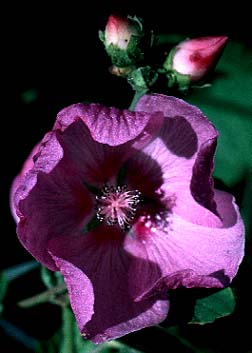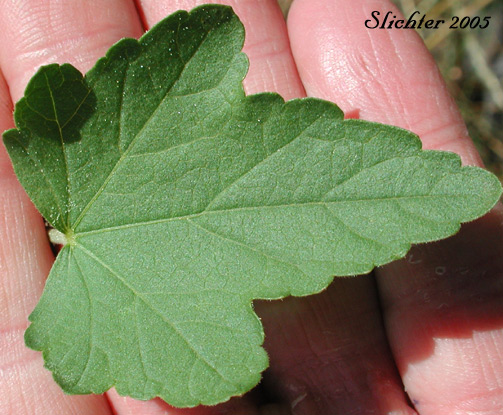

 The
photo at right shows the leaf of mountain hollyhock as seen at about 4000' at
a logging landing atop a ridge that divides the Cougar and Dairy Creek drainages
at the southeastern corner of Mt. Adams.......July 10, 2005.
This is the only plant of this species to be seen so far on Mt. Adams.
The
photo at right shows the leaf of mountain hollyhock as seen at about 4000' at
a logging landing atop a ridge that divides the Cougar and Dairy Creek drainages
at the southeastern corner of Mt. Adams.......July 10, 2005.
This is the only plant of this species to be seen so far on Mt. Adams.
Also known as stream-bank globe mallow, mountain hollyhock is an attractive perennial which is very suitable for the garden. Plants have several to many stout, erect stems that are often branched and measure from 50-120 cm high. The stems are covered with fine, minute, star-shaped hairs. The petiolate leaves are on the stems and measure from 8-15 cm wide. The base of the leaf is deeply heart-shaped and the margins are deeply 5-7 lobed, the lobes triangular with acute tips (See photo below.). The margins of the lobes are also lined with rounded teeth.
The inflorescence is an open raceme, with the main stem and pedicels covered with fine, star-shaped hairs. Each flower is subtended by a bract which is especially leaf-like below and reduced in size upwards, but always longer than the pedicel. The calyx is 7-10 mm long and densely covered with star-shaped hairs. The lobes of the calyx are wide with acute tips and are much longer than the narrowly linear bractlets. The deep rose-purple to pale pink petals are 2-2.5 cm long.
Mountain hollyhock is often found along streams or on moist slopes in canyons and in the foothills, although it may be found up to 7500 feet in elevation in the mountains at the southern extent of its range.
Mountain hollyhock may be found east of the Cascade Mts. from British Columbia south to Oregon and east to Montana and Colorado.
In the Columbia River Gorge, it may be found between the elevations of 700'-3900' from east of Cape Horn to the Klickitat River.